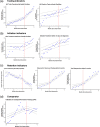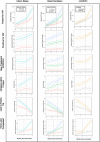Does a youth intern programme strengthen HIV service delivery in South Africa? An interrupted time-series analysis
- PMID: 37051619
- PMCID: PMC10098286
- DOI: 10.1002/jia2.26083
Does a youth intern programme strengthen HIV service delivery in South Africa? An interrupted time-series analysis
Abstract
Introduction: Since 2018, Youth Health Africa (YHA) has placed unemployed young adults at health facilities across South Africa in 1-year non-clinical internships to support HIV services. While YHA is primarily designed to improve employment prospects for youth, it also strives to strengthen the health system. Hundreds of YHA interns have been placed in programme (e.g. HIV testing and counselling) or administrative (e.g. data and filing) roles, but their impact on HIV service delivery has not been evaluated.
Methods: Using routinely collected data from October 2017 to March 2020, we conducted an interrupted time-series analysis to explore the impact of YHA on HIV testing, treatment initiation and retention in care. We analysed data from facilities in Gauteng and North West where interns were placed between November 2018 and October 2019. We used linear regression, accounting for facility-level clustering and time correlation, to compare trends before and after interns were placed for seven HIV service indicators covering HIV testing, treatment initiation and retention in care. Outcomes were measured monthly at each facility. Time was measured as months since the first interns were placed at each facility. We conducted three secondary analyses per indicator, stratified by intern role, number of interns and region.
Results: Based on 207 facilities hosting 604 interns, YHA interns at facilities were associated with significant improvements in monthly trends for numbers of people tested for HIV, newly initiated on treatment and retained in care (i.e. loss to follow-up, tested for viral load [VL] and virally suppressed). We found no difference in trends for the number of people newly diagnosed with HIV or the number initiating treatment within 14 days of diagnosis. Changes in HIV testing, overall treatment initiation and VL testing/suppression were most pronounced where there were programme interns and a higher number of interns; change in loss to follow-up was greatest where there were administrative interns.
Conclusions: Placing interns in facilities to support non-clinical tasks may improve HIV service delivery by contributing to improved HIV testing, treatment initiation and retention in care. Using youth interns as lay health workers may be an impactful strategy to strengthen the HIV response while supporting youth employment.
Keywords: HIV infections/prevention and control; community health workers; delivery of healthcare; health workforce; quasi-experimental studies.
© 2023 The Authors. Journal of the International AIDS Society published by John Wiley & Sons Ltd on behalf of the International AIDS Society.
Conflict of interest statement
The Aurum Institute provides funding to Youth Health Africa. SR was an employee of Youth Health Africa. No other authors declare any potential competing interests.
Figures



References
-
- UNAIDS . Country Fact Sheets: South Africa 2020 [Internet]. [cited 2021 Oct 22]. Available from: https://www.unaids.org/en/regionscountries/countries/southafrica
Publication types
MeSH terms
Grants and funding
LinkOut - more resources
Full Text Sources
Medical

